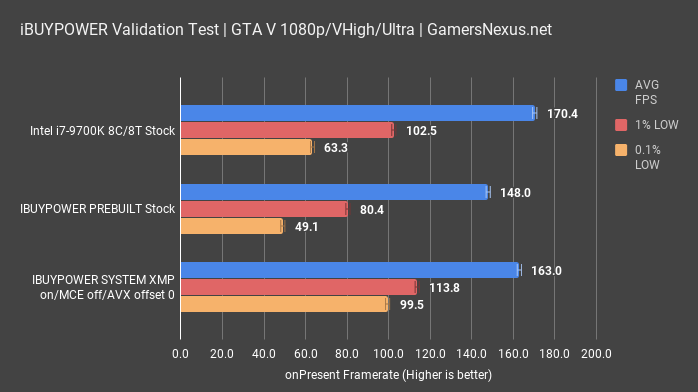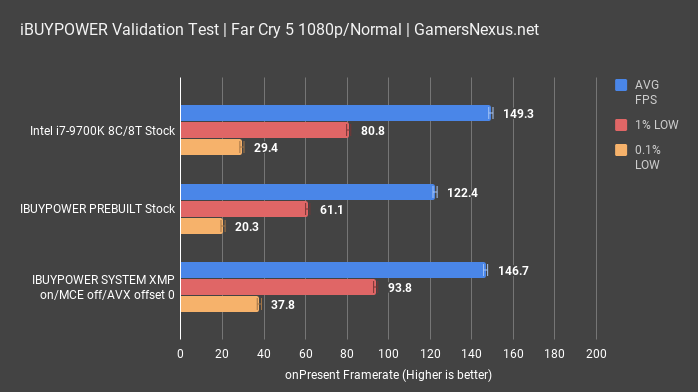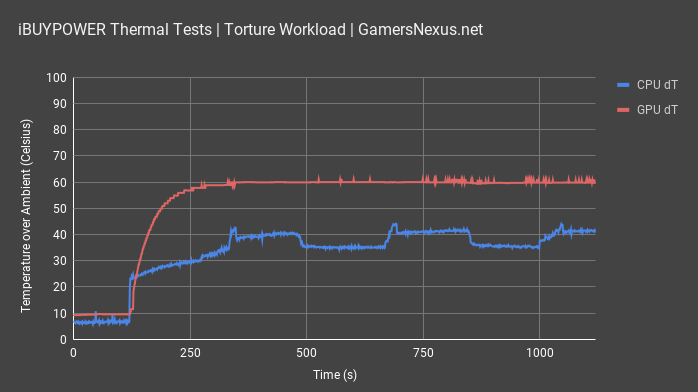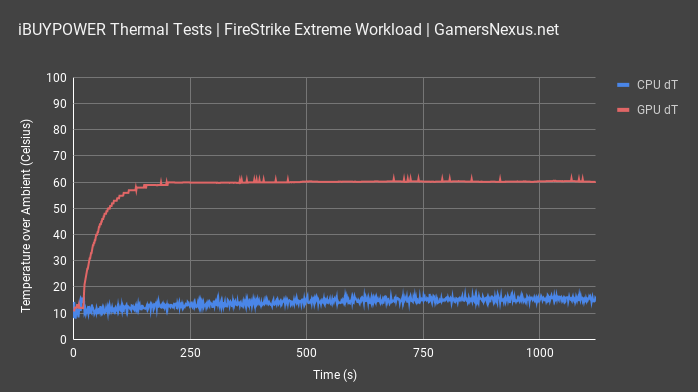In a post-Linum TI world, it’s likely that a lot of you look at system integrators a little differently – or, more likely, exactly the same. After we began our Walmart system review, we put in a last-minute, rushed order for an iBUYPOWER RDY system with significantly better parts than what we could get in the Walmart build. This was before Linus had begun his series, too, and so all we knew was that the parts listing included a 9700K instead of an 8700, clearly an improvement, and an RTX 2080 instead of a GTX 1080 Ti, and iBUYPOWER did this at a lower price. The question was whether or not the assembly was any good and if any other mistakes were made along the way.
Before starting on this one, we need a trip down memory lane: We had just ordered the Walmart system, originally meant to be an i7-8700 non-K CPU with GTX 1080 Ti, and had paid over $2000 to get it. Of course, that fateful order ended up being accidentally shipped with an 8700 with a GTX 1070 and was actually the $1500 SKU, but close enough. The motherboard was an H310 platform that runs a slower DMI and only one DIMM per channel, the case had literally 3-4mm of space between the glass and the front panel, and the USB3 cable was held in with glue. Off to a good start.
But before we even opened that box, we pinged iBUYPOWER and placed a heavily rushed order. iBUYPOWER pulled one of their RDY systems off of the floor and shipped it to us. If you’re not familiar with it, RDY is a program where iBUYPOWER pre-builds certain SKUs to ship systems out within a day or so, ending up faster than custom builds. For this one, we asked for a system with a budget equal to the Walmart machine at roughly $2000. iBUYPOWER obliged, shipping an i7-9700K, RTX 2080, and delivering the right system to HQ.
There were mistakes made in this build – pretty significant ones, actually – but they weren’t discovered until we got to benchmarking. The assembly quality itself was good, parts selection was reasonable, and shipping was competent. It’s BIOS where issues emerged.
Before getting to that testing, let’s take a look at build quality.
Parts Choices
When we first requested this machine, back around early December, the system would have cost about $2231. That included the RTX 2080, 9700K, all the other components, and the assembly and warranty. Identical or similar parts, where identical ones were unavailable, could be purchased for about $1986. Strictly like-for-like, comparing the cost of the same parts versus iBUYPOWER, this is a good deal. It’s about $200 of overhead to build the system, which we think is fair. You aren’t being over-charged for components. If you were to instead pick parts that run a bit cheaper but produce the same quality build, you could get the build done for about $1850. There was a $90 price difference in the GPU selection, a $20 difference in the cooler – using a Noctua NH-U14S instead of a Kraken M22 – a $30 price change in RAM, and similar. Note that we did not factor Windows 10 into this since it’s basically free now, though there is technically some value in the license granted by iBUYPOWER.
The difference is that iBUYPOWER gets a lot of its chosen parts for far cheaper than we ever could. One example would be the M22 cooler by NZXT: Although paying $80 retail is completely insane, that’s not really what you or iBUYPOWER are paying for it. NZXT is in the same building as iBUYPOWER. Moving inventory from one company to the other is logistically trivial and cuts a lot of shipping costs out of the equation, aiding in driving price down. Other companies, like Intel and NVIDIA, might sometimes give MDF to help in the sale of systems using certain parts.
Testing
Before getting to the testing, a few notes: This system was built before Linus’ series happened. Since then, in speaking with iBUYPOWER, the company has made significant internal changes to improve the quality assurance process. Several checks have been put in place to try and mitigate some of the issues we found, but the mistakes still happened, and they’re still sort of a big deal, so we’d advise you to keep an eye out.
The motivation to pay a little extra for a prebuilt system is the knowledge that the hardware will be completely assembled and preconfigured. The target customer for this system will plug their peripherals in, hit the power button, and install Steam without ever needing to know what a BIOS is, so that’s essentially what we did for the first round of tests. For thermals, we ran our standard case testing suite, and for general performance we ran our CPU testing suite. The results from these tests are absolutely not comparable to our previously published CPU and case benchmarks; we just used these tests because we had already made them.
Despite this, we couldn’t resist making a sanity check comparison between our previous 9700K CPU testing results and the iBUYPOWER system. In the process, we noticed something odd: the iBUYPOWER system was underperforming in a way that reached beyond the expected difference due to using a different GPU/motherboard/memory kit.
Entering BIOS revealed one obvious cause. All settings had been set to default values, so no XMP was enabled, and our “3200MHz” memory was running at 2666MHz. LTT noted the same mistake in their recent coverage of an iBUYPOWER system, but our problems extended further thanks to our old friend, Muti-Core Enhancement. The board used in our system was an ASUS Prime Z390-P with the oldest publicly available BIOS installed. In this BIOS version, setting MCE to Auto affects the CPU frequency. This in itself isn’t bad: we’re not trying to do a baseline CPU benchmark here, and if iBUYPOWER wants to soft-overclock their systems then that’s their prerogative. The problem is that, for whatever reason, this old version of MCE actually UNDERclocks the 9700K, locking it to 3.8GHz on all cores under sustained load rather than the 4.1-4.2GHz seen when MCE is manually disabled.
There were multiple ways for iBUYPOWER to avoid this problem. Selecting XMP II in the ASUS BIOS brings up a prompt that asks whether the user would like to enable or disable MCE, so the XMP and MCE problems could both be solved by toggling a single menu option. Also, updating the BIOS to the most recent version not only fixed MCE so that it behaved as expected (4.7GHz on all cores under sustained load), but it also disables MCE altogether if “Auto” is chosen. To be fair, a newer BIOS revision may not have been available when the system was assembled. It’s not iBUYPOWER’s fault that this BIOS version has a bug in it, but it is their fault for not tuning BIOS settings at all and potentially avoiding the bug.
Speaking with iBUYPOWER, these are all things that have been lined-up for resolution, particularly following the series that Linus Tech Tips ran.
Games
For other results, as we showed earlier, it was pretty obvious when something was wrong. Far Cry 5 at 1080p gives clear insight to the problem: The 9700K review put the CPU at 149FPS AVG, with the out-of-box iBUYPOWER test landing us at 122FPS AVG. Enabling XMP and fixing the broken frequency setting got us back up to 147FPS AVG on iBUYPOWER, illustrating an out-of-box loss of 17%. We saw similar results with GTA V at 1080p, where the stock result was 170FPS with our 2080 Ti bench, the out-of-box iBUYPOWER result was 148FPS AVG, and the updated system did 163FPS AVG. That’s another 9% decay in performance from a bad configuration.
Thermals
The thermal performance of iBUYPOWER’s system can’t be directly compared against any of our previous case reviews, since the components used are completely different. Even if they were similar, the blower cooler on the GPU and the CLC on the CPU are completely different from our standard case testing bench. For the Walmart prebuilt, we simply swapped in our normal components and treated it like a case review, but there was no point in doing that for iBUYPOWER, since the case is one that we’ve already thoroughly covered.
The initial CPU torture test at the previously mentioned flawed stock settings (MCE on, XMP off etc.) resulted in a dT of 38.2C, which remained effectively the same at 39.1C with the GPU fan locked at 55%. When the CPU was set to its proper clock speeds, temperatures rose slightly to 41.3C dT. These temperature deltas result from logged CPU temperatures in the low- to mid-60s Celsius, which is more than reasonable for a system running a sustained Prime95 workload. This specific CLC design is one that we’ve reviewed and were unimpressed by, but the fact remains that it’s a liquid cooler and is perfectly adequate for this system.
GPU temperatures are the most pertinent for this review, since the 2080 packaged in our system uses a relatively inexpensive single-fan blower cooler, while even Nvidia branded cards have made the move to dual-fan coolers. At stock settings with the default fan curve, the GPU maintained a dT of 60C. That’s warm, but it’s also determined entirely by the max temperature the card attempts to maintain, which seems to be 82 or 83 Celsius. The GPU fan levelled out at a constant 43% speed to stay at this temperature, or roughly 1900RPM.
The alterations to XMP and MCE predictably had no significant effect on GPU temperatures, which averaged 48.8C dT.
Firestrike was the last of the tests that we bothered performing with the default GPU fan curve. GPU dT averaged 56.7C, and it would almost definitely have averaged between 55 and 60C dT in any test that fully loaded the GPU, since that was the target temperature range. With fan speeds locked, GPU dT was about the same as it was in the torture test, 48.2C and then 49.2C with the XMP and MCE changes.
We measured this system at 42.8dBA with the GPU fan locked to 55%, but it could be much quieter with the fan allowed to spin down. It’s a bit odd to measure the noise of this full system when it’s relatively unlikely that someone will purchase exactly the same configuration with exactly the same fans and coolers, so check our S340 Elite and Kraken M22 reviews for some more specific and relevant numbers.
Conclusion
iBUYPOWER is working on its processes and has put more oversight in place between the customer and the assembly line. Many of the issues we encountered were also seen by Linus, and so the right moves have been made to try and correct this (in theory). We did encounter some unique and major issues, like MCE and the out-of-date BIOS, but iBUYPOWER was made aware of this as well.
The assembly quality and parts selection were both good to reasonable. iBUYPOWER certainly did better than Walmart, but iBUYPOWER is more competing with the likes of CyberPower, Xidax, and other SI companies. iBUYPOWER needs the most work on its configuration, which is a better place to be than needing work on parts selection and assembly quality. Once the company can correct its configuration, the builds will be reasonably good value. There isn’t much of an upcharge on these ($200 part-for-part, or ~$400 if selecting alternative parts), and the upcharge that does exist is reasonable to demand for the time required to assemble a system. As always, it’s just that the assembly has to be right and the configuration has to be perfect, since that’s the whole point of paying someone to do the work. iBUYPOWER failed on the configuration point, but is aware of the issues and hopefully correcting them.
Overall, we found the experience mixed, but think that these issues are correctable.
Editorial, Host: Steve Burke
Testing, Editorial: Patrick Lathan
Video: Andrew Coleman



